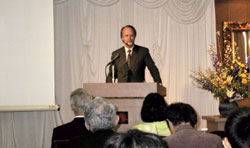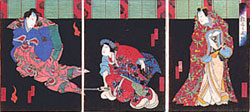|
|

|
keynote address

|
-
The linguistic meanings of "Quietness"
Yrjo Sotamaa
Professor, President / University of Art and Design Helsinki
 My name is Yrjo Sotamaa. I'm personally very honored to be here with you. First of all I would like to thank Japan Finland Design Association in Japan and Mr. Ekuan and all his collaborators for taking the effort to organize this symposium. My name is Yrjo Sotamaa. I'm personally very honored to be here with you. First of all I would like to thank Japan Finland Design Association in Japan and Mr. Ekuan and all his collaborators for taking the effort to organize this symposium.
The initiative of establishing an association came from Mr. Ekuan about 4 years ago. At that time I was working to establish the Finnish Institute in Japan. Finland had the experience of a good and close relationship with Japan, but we were missing an organization that would help us to keep that contact alive. Therefore the Finnish Science Community, The Finnish Industry, The Finnish State decided to establish the Finnish Institute in Japan which has now been operating here since December 1997. But we felt that it was not enough to have the institute in Japan, we needed also to establish wider professional contacts. We wanted to bring together people with special skills and talents and know-how to build a professional bridge between Japan and Finland. Therefore the Association was built.
I think the other idea was that we felt that in the world of architecture and in the world of design our countries have a particular role. If you look at the past history of modern architecture and modern design the key players have been Japan and Finland. We felt that our countries should and could have also in the future an important role in shaping the human environment, the physical environment that gives possibilities for our existence.
I think that the third reason for bringing us together was that Japan and Finland have both become key players in the development of information and communication technologies. And there again I think our countries shear something in the common, we are not only good in hard technology but we have a capability and interest to humanize technology, we want to find the applications of advance technologies which serve the humane interest and respect human dignity. I think there our countries go hand in hand. We are competing but we are doing many things together.
The fourth reason for coming together is related to the transition of design. Design has new role in our societies in and in the global economy. Design has become a very important element in developing our economies, our industry and our services. And when I read the annual report of NOKIA, one of the kinds of supporters of this event, they nominate 3 key value drivers in their business. They are advanced technology, user-friendly applications of technology and design. And two of these 3 are related to design: developing user-friendly solutions and applications and design itself, the shaping of the cultural value of the products. Design has a new role in shaping the global economy.
We talk also about that the esthetic dimension of the life is expanding. Visual culture, aesthetic culture is becoming more dominant part in our lives and therefore design is getting or gaining special importance.
An important aspect related the transition of design is the need to harmonize our environment. The issues that Mr. Ekuan recently spoke about were concerned with the quality of the environment, understanding the spiritual meaning of the material world. Design and architecture are very powerful tools in shaping these things. These were the reasons for establishing this cooperation, of which this symposium is an important part of.
 Then to quietness. We have discussed the meaning of it the past symposium in Finland. We felt that maybe we had a limited view on the word, because we both were using an English word Quietness. We used a word that was outside of our cultures. Therefore we asked a Finnish author, a translator who has translated a lot of Japanese literature and poesy to Finnish, Kai Nieminen would look at the linguistic meanings of Quietness. And I will use his analysis as a base of my presentation. Then to quietness. We have discussed the meaning of it the past symposium in Finland. We felt that maybe we had a limited view on the word, because we both were using an English word Quietness. We used a word that was outside of our cultures. Therefore we asked a Finnish author, a translator who has translated a lot of Japanese literature and poesy to Finnish, Kai Nieminen would look at the linguistic meanings of Quietness. And I will use his analysis as a base of my presentation.
Quiet in Finnish can be translated as hiljainen. Hiljainen is the general equivalent of the English word quiet. Kai Nieminen has found 3 main lines in Japanese that could be associated with quiet or hiljainen. The first I "shizuka" what's in Finnish would mean hiljainen, aancton, liikkumaton, hnomaamaton and in English soundless, unmoving, unnoticed. And the second line would be "odayaka" which is again hiljainen. But in Finnish it could also be called or translated tyyni, hillitty, leppca and in English; calm, restrain, gentle. And the third is the "yasuraka" and in Finnish it would mean rauhallinen, levollinen, vakaa, screne, tranquil and stable.
The three main lines mentioned above are based on the Japanese's words "shizuka", "odayaka" and "yasuraka". The words are interesting from a morphological viewpoint, because (like the English "quiet" or the Finnish "tyyni") they are somewhat ambiguously both adjectives and nouns at the same time. In a way, they are elliptic words, such as the Finnish word "sini", which in the phrase "taivaan sini" (the blue of the sky) acts as a noun, whereas in the compound word "sinitaivas" (the blue sky) it is adjectival. Moreover, when it occurs in un-idiomatic phrases, it needs a particle-like suffix: "sininen kukka" (a blue flower). In Japanese, such words can take the inflectional suffix "na" which indicates an attributive relationship: "shizukana" = quiet; or the postposition "ni" indication an adverbial function "ni":"shizuka ni" = quietly.
As the dictionary examples show, connotations (and nuances) in different languages are not isomorphic. Each language has its own cognitive system. In a way, Webster's first definition "still; calm; motionless" covers and in part blends all the three main lines of the Japanese; 1) unmoving/still, 2) calm/tranquil, 3) unmoving.
 On the other hand as the example shows Kai Nieminen has found 3 specifying Finnish synonyms for each Japanese word. The purpose is to characterize not to define. The word acquires it's meaning only in is contexts. And of course in our case we would look for the meaning of quiet in the context of architecture and design, in the context of the physical word that we are shaping with the tools we have. But in this lecture I will look at the linguistic explanations of quiet. On the other hand as the example shows Kai Nieminen has found 3 specifying Finnish synonyms for each Japanese word. The purpose is to characterize not to define. The word acquires it's meaning only in is contexts. And of course in our case we would look for the meaning of quiet in the context of architecture and design, in the context of the physical word that we are shaping with the tools we have. But in this lecture I will look at the linguistic explanations of quiet.
In natural communication (speech, literature), words do not have an absolute meaning; this applies equally to the original communication situation as to its translation. The context, allusions and functions together create the framework within which the word communicates thought and meaning. In an ironic vein, I would like to refer to a recent fashionable phrase "tacit knowledge", which was translated into Finnish as "hiljainen tieto" (quiet knowledge), which has nothing to do with the meaning of the word "quiet" in this context.
The equivalents of the English "quiet" presented here do not contain the allusion in the Finnish word "hiljaa" as "slow, slowly": "ajaa hiljaa" to drive slowly. It is easy to associate this meaning with the meaning "rauhallinen, levollinen" (calm, tranquil), but an understanding that the adverb "hiljakkoin; hiljan; hiljattain" denotes the near past requires an intuitive understanding of the fact that "hiljaa" = "hitaasti" (quietly =slowly), and the "aika on hidas eika ole viela ehtinyt paljonkaan kulua" (time is slow and has not had very much time to pass) So, hiljaa, the translation of quiet in Finnish refers also to slowly. And I think that's an important aspect in terms of architecture and design. Architectures doesn't only deal with the physical word, it also deals with our experience in time.
A Finnish speaker has no trouble understanding the lyrics of the Finnish tango "Rannalla" by Tuula Heikkila; "Niin hiljaa, niin hiljaa jai/Kaipaamaan suudelmiaan. Niin hiljaa, niin hiljaa kay rannalle uneksimaan;/'Jos rakkaani jallen laiva valkoinen tois, /niin hiljaa, niin hiljaa jaada syliini vois"? But how to translate all those phrases "niin hiljaa" into English; Quiet? Still? Silently? Gently? Or into Japanese : Shizuka? Odayaka? Yasuraka? Here, we find yet another nuance of the Finnish word "hilajaa": a resigned, melancholy submission to fate.
 One of the most famous women in Japanese history was Shizuka, a dancer from Kyoto who lived in the 12th century, and who became the lover of Yoshitsune, the most celebrated of all the romantic warriors and the hero of countless tales, ballads and plays. When Yoshitsune's brother, Yoritomo, was plotting to assassinate Yoshitsune, Shizuka got wind of the plot and warned her lover. Yoshitsune fled, but Shizuka ended up as prisoner of Yoritomo. However, even though Yoritomo threatened to kill her, she refused to reveal Yoshitsune's hiding place. When Yoritomo forced her to dance for him, she improvised a poignant love song about her yearning love for Yoshitsune during the dance. Enraged, Yoritomo later took revenge by drowning Yoshitsune and Shizuka's child. Shizuka is the archetype of the faithful, heroic, self-sacrificing woman. One of the most famous women in Japanese history was Shizuka, a dancer from Kyoto who lived in the 12th century, and who became the lover of Yoshitsune, the most celebrated of all the romantic warriors and the hero of countless tales, ballads and plays. When Yoshitsune's brother, Yoritomo, was plotting to assassinate Yoshitsune, Shizuka got wind of the plot and warned her lover. Yoshitsune fled, but Shizuka ended up as prisoner of Yoritomo. However, even though Yoritomo threatened to kill her, she refused to reveal Yoshitsune's hiding place. When Yoritomo forced her to dance for him, she improvised a poignant love song about her yearning love for Yoshitsune during the dance. Enraged, Yoritomo later took revenge by drowning Yoshitsune and Shizuka's child. Shizuka is the archetype of the faithful, heroic, self-sacrificing woman.
What are the connotations attached to her name ("hiljainen", "quiet")? Surely not the "resigned, melancholy submission to fate" referred to above. Shizuka is a tragic heroine not unlike Aino, in the Finnish national epic, Kaelvala, who was also capable of strong resistance, a mistress of her own fate. I suspect that for the Japanese, the qualities, associated historically with the name Shizuka now constitute connotations of the word (subconscious ones not include in dictionary definitions).  Shizuka was brave, faithful, gentle, beautiful, restrained, kind, and purposeful; despite her background as a dancer, she was not brash, noisy, frivolous or arrogant. Shizuka was brave, faithful, gentle, beautiful, restrained, kind, and purposeful; despite her background as a dancer, she was not brash, noisy, frivolous or arrogant.
These few examples of the linguistic interpretation of the simple word shizuka or hiljainen or quiet and the real meaning of the word or the idea can only be created in certain contexts. There's no absolute explanation or translation of the word and I think understanding fully the meaning of quiet or hiljainen or sizuka we should go into the Japanese or Finnish literature and find interpretations from their stories.
I 'd like to end my short presentation by publishing the first physically visible result of Japan Finland Design Association activities. This is a book that we have edited and printed of the speeches and discussions we had in Finland under the White Nights Symposium. The white nights are both pleasant and peaceful, as you will notice. I'd like to ask all the Japanese members of the Japan Finland Design Association to come forward and Iユd like to give the copy of the book to you. When you all leave this room you will be able to ask for a copy for yourself from the front or from the door. You will get the copy of this book and you can read it in peace and quietness and hopefully enjoy the thoughts.
Thank you heartily for the opportunity to speak to this distinguished audience.
 Secretariat
Secretariat
Japan Finland Design Association (Japan)
c/o The Finnish Institute in Japan
3-5-39 Minami Azabu, Minato-ku, Tokyo, Japan 106-8561

c/o GK Graphics Incorporated
telephone : 03-5952-6831 facsimile : 03-5952-6832
e-mail : jfda@gk-design.co.jp
previous
| |
|
